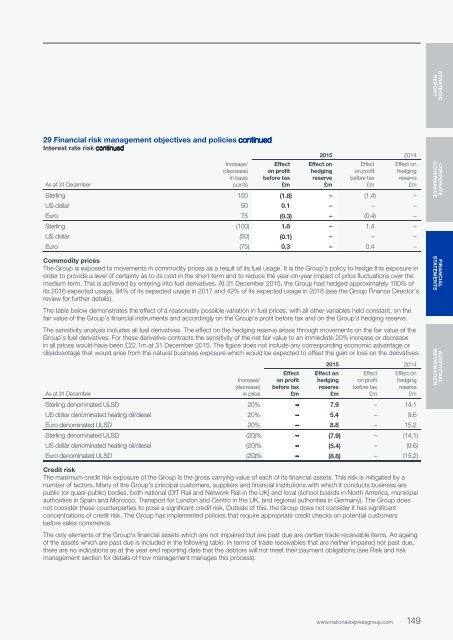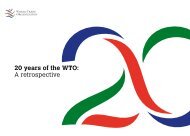nex-ar2015-full
Create successful ePaper yourself
Turn your PDF publications into a flip-book with our unique Google optimized e-Paper software.
Notes to the Consolidated Accounts continued<br />
For the year ended 31 December 2015<br />
STRATEGIC<br />
REPORT<br />
29 Financial risk management objectives and policies continued<br />
Interest rate risk continued<br />
2015 2014<br />
As at 31 December<br />
Increase/<br />
(decrease)<br />
in basis<br />
points<br />
Effect<br />
on profit<br />
before tax<br />
£m<br />
Effect on<br />
hedging<br />
reserve<br />
£m<br />
Effect<br />
on profit<br />
before tax<br />
£m<br />
Effect on<br />
hedging<br />
reserve<br />
£m<br />
Sterling 100 (1.8) – (1.4) –<br />
US dollar 50 0.1 – – –<br />
Euro 75 (0.3) – (0.4) –<br />
Sterling (100) 1.8 – 1.4 –<br />
US dollar (50) (0.1) – – –<br />
Euro (75) 0.3 – 0.4 –<br />
Commodity prices<br />
The Group is exposed to movements in commodity prices as a result of its fuel usage. It is the Group’s policy to hedge this exposure in<br />
order to provide a level of certainty as to its cost in the short term and to reduce the year-on-year impact of price fluctuations over the<br />
medium term. This is achieved by entering into fuel derivatives. At 31 December 2015, the Group had hedged approximately 100% of<br />
its 2016 expected usage, 94% of its expected usage in 2017 and 42% of its expected usage in 2018 (see the Group Finance Director’s<br />
review for further details).<br />
CORPORATE<br />
GOVERNANCE<br />
FINANCIAL<br />
STATEMENTS<br />
The table below demonstrates the effect of a reasonably possible variation in fuel prices, with all other variables held constant, on the<br />
fair value of the Group’s financial instruments and accordingly on the Group’s profit before tax and on the Group’s hedging reserve.<br />
The sensitivity analysis includes all fuel derivatives. The effect on the hedging reserve arises through movements on the fair value of the<br />
Group’s fuel derivatives. For these derivative contracts the sensitivity of the net fair value to an immediate 20% increase or decrease<br />
in all prices would have been £22.1m at 31 December 2015. The figure does not include any corresponding economic advantage or<br />
disadvantage that would arise from the natural business exposure which would be expected to offset the gain or loss on the derivatives.<br />
2015 2014<br />
Effect<br />
on profit<br />
before tax<br />
£m<br />
Effect on<br />
hedging<br />
reserve<br />
£m<br />
Effect<br />
on profit<br />
before tax<br />
£m<br />
Effect on<br />
hedging<br />
reserve<br />
£m<br />
Increase/<br />
(decrease)<br />
As at 31 December<br />
in price<br />
Sterling denominated ULSD 20% – 7.9 – 14.1<br />
US dollar denominated heating oil/diesel 20% – 5.4 – 9.6<br />
Euro denominated ULSD 20% – 8.8 – 15.2<br />
Sterling denominated ULSD (20)% – (7.9) – (14.1)<br />
US dollar denominated heating oil/diesel (20)% – (5.4) – (9.6)<br />
Euro denominated ULSD (20)% – (8.8) – (15.2)<br />
ADDITIONAL<br />
INFORMATION<br />
Credit risk<br />
The maximum credit risk exposure of the Group is the gross carrying value of each of its financial assets. This risk is mitigated by a<br />
number of factors. Many of the Group’s principal customers, suppliers and financial institutions with which it conducts business are<br />
public (or quasi-public) bodies, both national (DfT Rail and Network Rail in the UK) and local (school boards in North America, municipal<br />
authorities in Spain and Morocco, Transport for London and Centro in the UK, and regional authorities in Germany). The Group does<br />
not consider these counterparties to pose a significant credit risk. Outside of this, the Group does not consider it has significant<br />
concentrations of credit risk. The Group has implemented policies that require appropriate credit checks on potential customers<br />
before sales commence.<br />
The only elements of the Group’s financial assets which are not impaired but are past due are certain trade receivable items. An ageing<br />
of the assets which are past due is included in the following table. In terms of trade receivables that are neither impaired nor past due,<br />
there are no indications as at the year end reporting date that the debtors will not meet their payment obligations (see Risk and risk<br />
management section for details of how management manages this process).<br />
www.nationalexpressgroup.com<br />
149 149
















